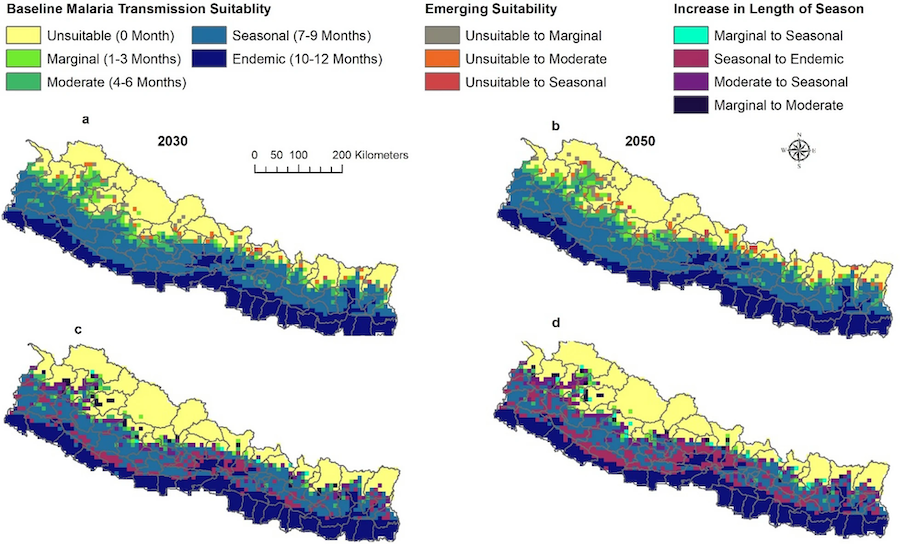
BHATTARAI, BLACKBURN, RYAN – Malaria transmission in Nepal under climate change: anticipated shifts in extent and season, and comparison with risk definitions for intervention
Shreejana Bhattarai, Jason K. Blackburn, & Sadie J. Ryan
Article first published online: 22 December 2022
DOI: https://doi.org/10.1186/s12936-022-04417-x
ABSTRACT:
Background: Climate and climate change affect the spatial pattern and seasonality of malaria risk. Season lengths and spatial extents of mapped current and future malaria transmission suitability predictions for Nepal were assessed for a combination of malaria vector and parasites: Anopheles stephensi and Plasmodium falciparum (ASPF) and An. stephensi and Plasmodium vivax (ASPV) and compared with observed estimates of malaria risk in Nepal.
Methods: Thermal bounds of malaria transmission suitability for baseline (1960–1990) and future climate projec- tions (RCP 4.5 and RCP 8.5 in 2030 and 2050) were extracted from global climate models and mapped for Nepal. Season length and spatial extent of suitability between baseline and future climate scenarios for ASPF and ASPV were compared using the Warren’s I metric. Official 2010 DoHS risk districts (DRDs) and 2021 DoHS risk wards (DRWs), and spatiotemporal incidence trend clusters (ITCs) were overlaid on suitability season length and extent maps to assess agreement, and potential mismatches.
Results: Shifts in season length and extent of malaria transmission suitability in Nepal are anticipated under both RCP 4.5 and RCP 8.5 scenarios in 2030 and 2050, compared to baseline climate. The changes are broadly consistent across both future climate scenarios for ASPF and ASPV. There will be emergence of suitability and increasing length of season for both ASPF and ASPV and decreasing length of season for ASPV by 2050. The emergence of suitability will occur in low and no-risk DRDs and outside of high and moderate-risk DRWs, season length increase will occur across all DRD categories, and outside of high and moderate-risk DRWs. The high and moderate risk DRWs of 2021 fall into ITCs with decreasing trend.
Conclusions: The study identified areas of Nepal where malaria transmission suitability will emerge, disappear, increase, and decrease in the future. However, most of these areas are anticipated outside of the government’s current and previously designated high and moderate-risk areas, and thus outside the focus of vector control interventions. Public health officials could use these anticipated changing areas of malaria risk to inform vector control interventions for eliminating malaria from the country, and to prevent malaria resurgence.
Read the full publication at Malaria Journal.